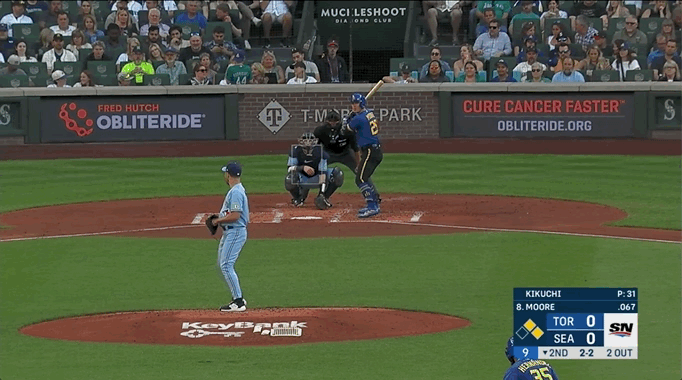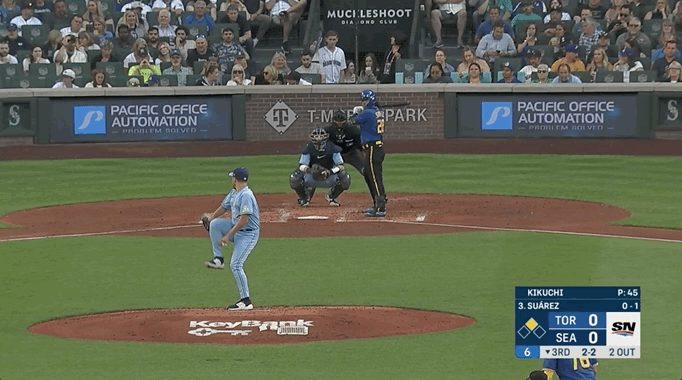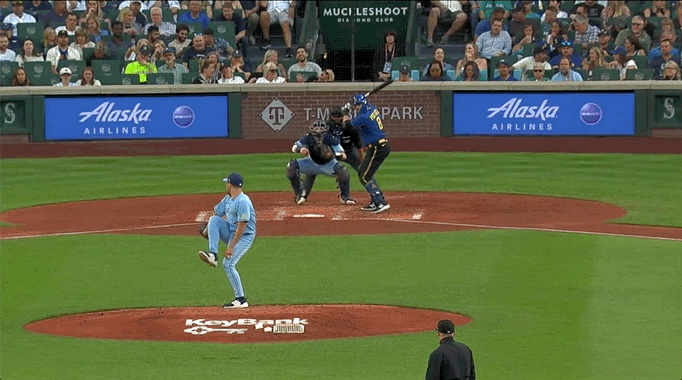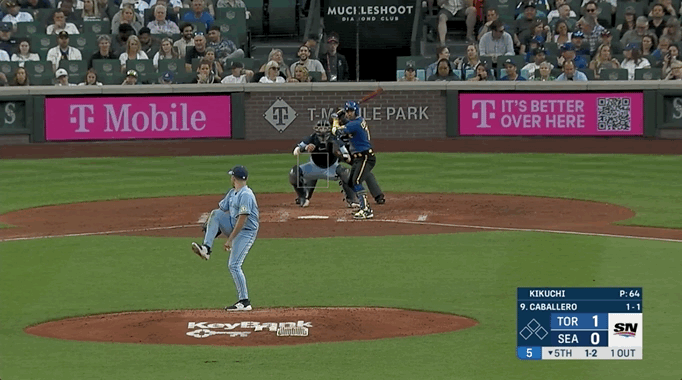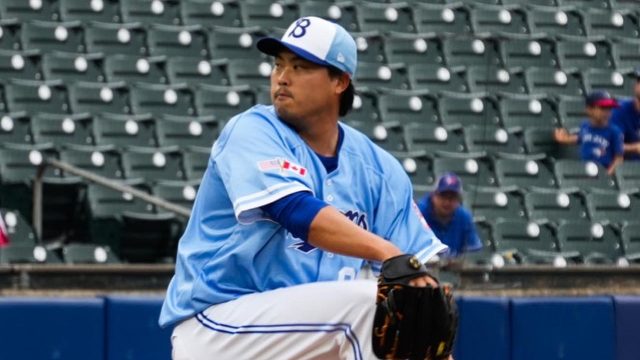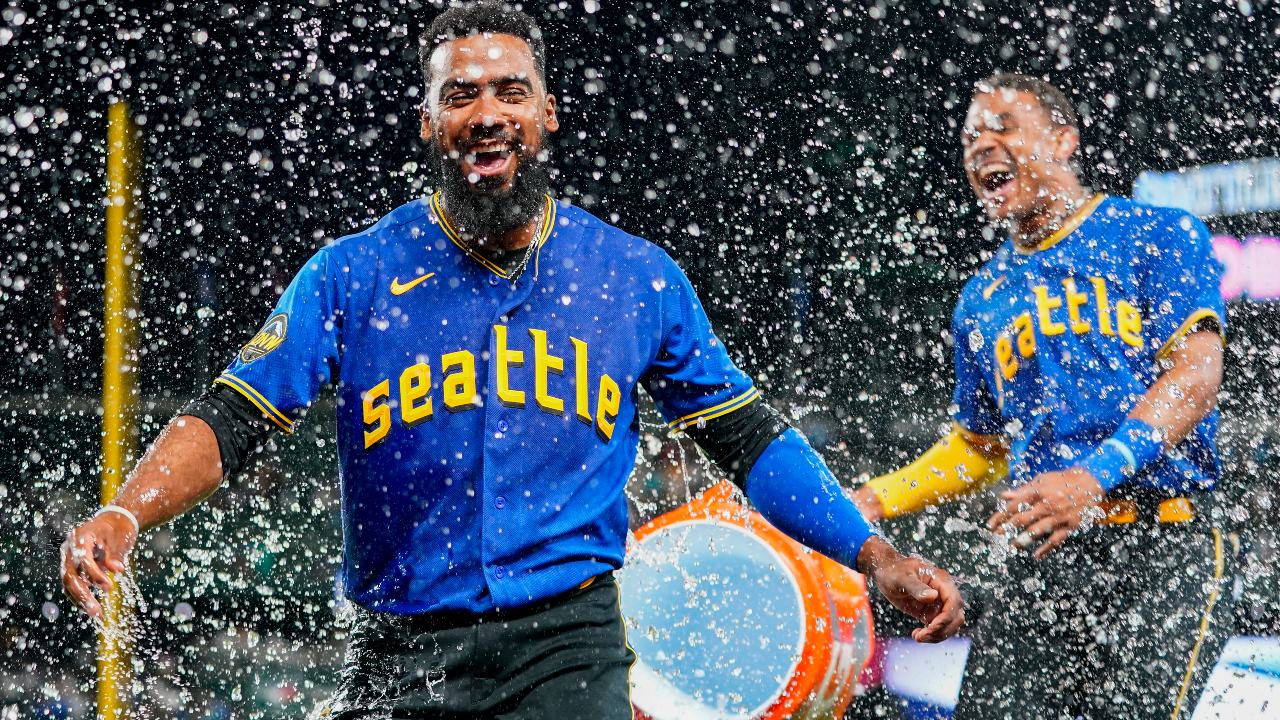
SEATTLE — Pitching in Seattle for the first time since he left the Mariners for free agency two winters ago, pitching before the tens of thousands of Western Canadians that wage an annual hostile takeover of T-Mobile Park, pitching in the place where he was a damn all-star, Yusei Kikuchi was feeling it:
That was striking out the side with two runners on in the second. Striking out a top-five home run hitter since 2019 with a runner in scoring position in the third? Still feeling it:
Kick save and a beauty to strand a leadoff single in the fourth? Feeling. It.
Sorry, you want to take this guy out of the rotation? You want Kikuchi to stop walking dudes and giving up screamers and allowing so many baserunners? You fool. He has to let the first batter reach in practically every inning he pitches. He can’t do stuff like this without runners on. It doesn’t get good until he’s in trouble.
Case in point — Friday, Kikuchi either walked or allowed a single to the leadoff hitter in each of his first four frames. He let a runner reach in five of the six innings he pitched in. And every time he opened that door, he slammed it in the ensuing Mariners faces.
Landing his fastball, curveball and slider for strikes, earning a whiff on over a third of Seattle’s swings, and pitching with a swagger that would have been ludicrous to suggest he even possessed only 12 months ago, Kikuchi worked 5.1 scoreless innings, striking out eight and walking off the mound to a standing ovation in a game the Blue Jays ultimately lost, 3-2. Were you not entertained?
Offence arrived in the fifth as Danny Jansen — who else? — yanked a first-pitch Bryce Miller fastball over the wall in left. And the seventh as Daulton Varsho — uh, who else? — legged out an infield single, stole second, took third on a groundball to the left side, and scored on a wild pitch.
Nervous moments developed in the seventh, as the Mariners, facing a two-run deficit, put a couple of runners in scoring position with none out against Trevor Richards. Enter old Mariners friend Erik Swanson, who allowed one of those runners to score on a bloop single but erased the other with a weak groundball to first as Brandon Belt gunned out AJ Pollock at the plate. Swanson loaded the bases two batters later but stranded all three by blowing away Eugenio Suarez with a 94-mph fastball at the height of the zone.
A letdown for all those Canadian invaders came in the eighth, as Alejandro Kirk — pinch-hitting against a left-hander for Varsho — grounded into a double play with one out and the bases loaded in the top half, before the Mariners tied the game with a bloop single and line-drive double off Yimi Garcia in the bottom.
And heartbreak in the ninth, when Blue Jays closer Jordan Romano put two runners on before surrendering a walk-off rocket to the right field wall off the bat of — yeah, who else? — Teoscar Hernandez.
All that late-game drama produced compelling scenes at an absolutely raucous T-Mobile, with relievers letting out roars at the end of their innings, fans of each side erupting around them and Hernandez thumping his chest as he ended it. No matter which currency you used to buy your ticket, you got your money’s worth.
But the best juice in this one for the many, many Blue Jays fans packing out an enemy ballpark was watching Kikuchi do his thing. Posing, strutting, leg-kicking. And although there has been some noise about the left-hander possibly reprising his late-season relief role of a year ago, which saw him strike out 40 per cent of the batters he faced from Toronto’s bullpen and pitch his way into a leverage spot by season’s end, there’s suddenly reason to believe Kikuchi will be staying right where he is in the club’s rotation.
Because if it’s a hard-throwing, homer-prone, left-handed reliever featuring the ability to throw multiple innings, a tight slider and a loose grip on where, exactly, their pitches are going, well, the Blue Jays just acquired him in Genesis Cabrera.
And good thing they did. With lone bullpen lefty Tim Mayza (44 appearances), plus de facto second lefties Swanson (46 appearances) and Richards (40.1 innings), having logged high workloads to this point in the season, the Blue Jays have been seeking a way to add another relief option that can match up against tough left-handed hitters in middle innings. The hope is Cabrera will fill that role, and allow Schneider to preserve Mayza, Swanson, and Richards for higher-leverage work later in games.
“We like the arm, the velo, the strikeout ability,” Schneider said. “We’re going to be facing lineups that are stacked with a lot of lefties coming up.”
Like the Dodgers, who regularly run batting orders with five left-handed hitters. Or the Angels, who are built around Shohei Ohtani, Mickey Moniak, Mike Moustakas and Matt Thaiss in the heart of their lineup. Or the Orioles and Red Sox, who the Blue Jays will face in a pair of significant series come the beginning of August.
The idea is to let Cabrera enter to face Gunnar Henderson and Adley Rutschman or Masataka Yoshida and Rafael Devers in the fifth or sixth inning behind a Blue Jays starter — say, when someone like Kikuchi is beginning their third trip through the order — allowing Schneider to hold onto Mayza, Richards, and Swanson as options to deploy in tough spots come the seventh or eighth.
“In a perfect world, it’s a little bit lower leverage to start,” Schneider said. “But it’s just another option that can really be tough on lefties.”
Of course, in Cabrera, the Blue Jays are acquiring an electric arm with plenty of promise and plenty to work on. In 2020 and ’21, Cabrera was sitting 97-98 with his fastball while pitching to a 3.41 ERA across 90 appearances in a set-up role with the Cardinals. But over the two seasons since he’s lost a couple ticks off his heater and struggled to keep fly balls in the yard, allowing 1.64 HR/9.
As Cabrera’s ERA increased — 4.81 over 71 appearances since the beginning of 2021 — the Cardinals’ trust in him diminished, and he finished his St. Louis tenure facing low leverage. When the club opted to designate him for assignment last week rather than optioning him to the minors, it said something subtle. When Cardinals manager Oliver Marmol offered that “I thought it was the right time for him to have a change of scenery,” it said something overt.
But the Blue Jays have a set of strategies they use to help pitchers facing issues such as Cabrera’s get back in the zone and keep balls in the yard. Schneider said the club already has some tweaks in mind that it plans to share with Cabrera once he joins the Blue Jays in the coming days — likely this weekend in Seattle if he can get his work visa sorted, and no later than next week in Los Angeles.
For his part, Cabrera’s already made some adjustments this year, slightly lowering his arm slot and releasing pitches closer to first base, which has juiced the horizontal movement of his fastball. He’s also started leaning on a 90-mph slider as his primary off-speed weapon. And in several appearances this season, he threw more sliders than fastballs.
That hitters have whiffed on Cabrera’s bullet slider 46.4 per cent of the time they’ve swung at it this season speaks to its utility. When he’s tunnelling it effectively off his fastball, Cabrera forces hitters to make a difficult decision between the two offerings which both come in harder than they’re accustomed to seeing from a left-hander. It’s strikingly similar to how Kikuchi pitched in relief last season.
And, in a funny turn of fate, Cabrera’s addition may have just bought Kikuchi more time in the rotation. More opportunities for performances like Friday’s when everything’s working. More leg kicks, more poses, more strikeout struts. And in that case, everyone wins.


